By Albert Haim
Introduction.
It
is well-known that, following the release of the Wolverine's records, Bix's
genius as a cornetist and jazz innovator became widely known among musicians.
Bix's reputation was further enhanced when his February 4, 1927 recording
of Singin' the Blues became available. Chauncey Morehouse, the drummer
in the 1926-1927 Jean Goldkette Victor Recording Orchestra stated,(see
Bix:
Mand and Legend by Richard Sudhalter and Philip Evans) “You couldn’t
go anywhere in New York without hearing some guy trying to play like Bix.
They copied his tone, his attack, his figures. Some guys tried to take
his stuff right off the records. Others just came and listened. It was
amazing.”Four yeas after the recording
was made, Bix's legendary solo in Singin' the Blues was copied almost
note for note by Rex Stewart in the two 1931 recordings of the tune by
Fletcher Henderson’s orchestra. According to Richard Sudhalter in Lost
Chords, “Bill Challis arranging Singin’ the Blues for Paul Whiteman’s
Orchestra in 1928, scored Trumbauer’s chorus for the entire reed section.
It got the same treatment on Fletcher Henderson’s two performances of the
piece: the reeds play Trumbauer together, before Rex Stewart renders Bix’s
equally famed thirty-two bars as a solo in the inflections and accents
of his own style. It was the first time such homage had been delivered
in so complete a fashion.”
The
seminal importance and impact of the Bix and Tram 1927 recording of "Singin'
the Blues" are well documented. What is not widely known is that some of
Bix's solos from his first three recording sessions with the Wolverine
Orchestra were also widely copied. In this article, I will describe the
circumstances surrounding this rather astonishing phenomenon.
Jazz
Me Blues.
On
February 18, 1924, at 3:30 A.M., eight musicians, one of them Leon Bix
Beiderbecke, left Cincinnati, Ohio and drove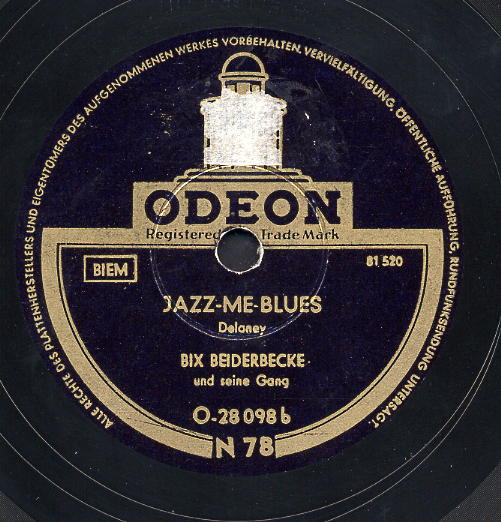 about 70 miles to Richmond, Indiana, the location of the Starr Piano Company's
Gennett recording studio. The Gennett Record Division of the Starr Piano
Company has been referred to as “The Cradle of Recorded Jazz.” Indeed,
it was. The New Orleans Rhythm Kings made their first recordings in 1922
and were followed in 1923 by Jelly Roll Morton and by King Oliver's Jazz
Band with Louis Armstrong. The Wolverines began recording in February 1924.
Pianist Dick Voynow and clarinetist Jimmy Hartwell had purchased a day's
recording. It was not unusual, at that time, for musicians to pay to record
their numbers. Recordings were generally viewed by musicians as a way of
promoting the bands for their live appearances rather than as sources of
income. There were exceptions, of course, notably Paul Whiteman’s orchestra
whose record sales numbered in the millions.
about 70 miles to Richmond, Indiana, the location of the Starr Piano Company's
Gennett recording studio. The Gennett Record Division of the Starr Piano
Company has been referred to as “The Cradle of Recorded Jazz.” Indeed,
it was. The New Orleans Rhythm Kings made their first recordings in 1922
and were followed in 1923 by Jelly Roll Morton and by King Oliver's Jazz
Band with Louis Armstrong. The Wolverines began recording in February 1924.
Pianist Dick Voynow and clarinetist Jimmy Hartwell had purchased a day's
recording. It was not unusual, at that time, for musicians to pay to record
their numbers. Recordings were generally viewed by musicians as a way of
promoting the bands for their live appearances rather than as sources of
income. There were exceptions, of course, notably Paul Whiteman’s orchestra
whose record sales numbered in the millions.
On
that particular day, the Wolverines cut four sides, but only two were mastered
and released, Fidgety Feet and Jazz Me 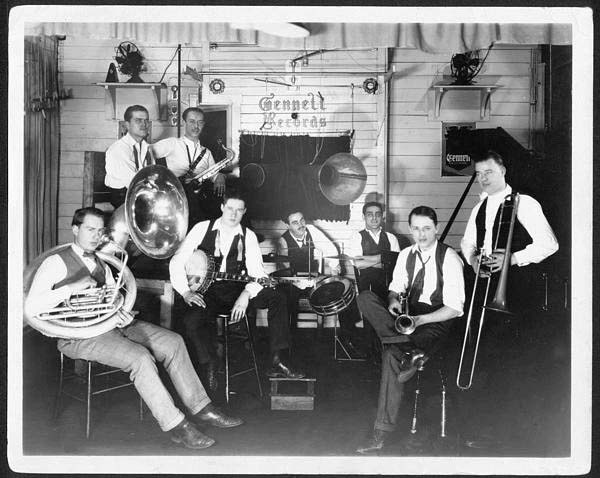 Blues.
The latter includes a 20-bar chorus by twenty-year-old Bix. It is a masterful,
geometric construction known as a “correlated chorus.” First two measures
are played; these are followed by two more measures, related to the first
two; then, four measures, related to the first four, follow, etc. Bix makes
use of triplets and rhythmic delays in his solo, characteristic features
of a style he will develop further as he matured. In discussing this solo,
Randy Sandke writes [see Bix Beiderbecke From a Musician's Perspective
in Annual Review of Jazz Studies]
“The overall impression we get from the solo, as in all of Bix at his best,
is that every note is spontaneous, yet inevitable.”
Blues.
The latter includes a 20-bar chorus by twenty-year-old Bix. It is a masterful,
geometric construction known as a “correlated chorus.” First two measures
are played; these are followed by two more measures, related to the first
two; then, four measures, related to the first four, follow, etc. Bix makes
use of triplets and rhythmic delays in his solo, characteristic features
of a style he will develop further as he matured. In discussing this solo,
Randy Sandke writes [see Bix Beiderbecke From a Musician's Perspective
in Annual Review of Jazz Studies]
“The overall impression we get from the solo, as in all of Bix at his best,
is that every note is spontaneous, yet inevitable.”
Four
months later, on June 26, 1924, George Olsen and His Orchestra recorded
You'll
Never Get to Heaven With Those Eyes. In this record, Red Nichols plays
a solo identical to the one played by Bix in the Wolverine's
Jazz Me
Blues. The note-for-note transcription was prepared by Eddie Kilfeather,
pianist and arranger with Olsen from 1924 until about 1929.Kilfeather
told Red that the solo he had given him for the Olsen recording of You'll
Never Get to Heaven with Those Eyes was Bix's solo from Jazz Me
Blues. Red was highly intrigued by Bix's solo. Early in July 1924,
on his way to Michigan to join Dick Bowen and His Blue Streak Orchestra
of New York, Red took a detour to see the Wolverines in Eastern Indiana.
This was the first time that Red and Bix met. Their friendship lasted until
Bix died, seven years later. As a matter of fact, two days before he died,
Bix called Red Nichols and talked at length with Bobbi, Red’s wife. The
meeting between Red and Bix early in July 1924, a few days after Bix had
recorded Tiger Rag with the Wolverines is important, as we will
see later, to solve the puzzle as to how Bix's solo from Tiger Rag
came to be copied on numerous recordings of the tune.
Copenhagen.
Brian
Rust, the noted jazz discographer/historian, ranks Charlie Davis’ composition
Copenhagen
among the top ten of his favorite jazz numbers. The first and last recordings
of Copenhagen are from May 6, 1924 (The Wolverine Orchestra) and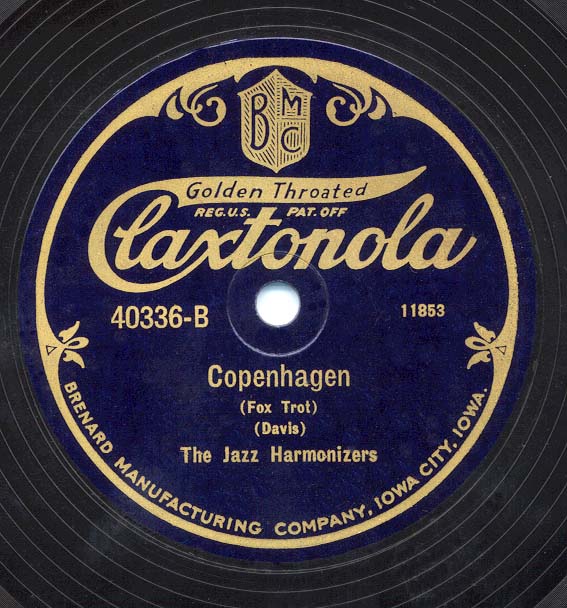 November 7, 2000 (Rob Fisher and The Coffee Club Orchestra in the album
Shaking
the Blues Away), respectively. In between these dates, hundreds of
recordings of the number have been released. Some of the jazz musicians/bands
who recorded Copenhagen are Louis Armstrong, Sidney Bechet, Bud
Freeman, Fletcher Henderson, Earl Hines, Kid Ory, Artie Shaw, The Dorsey
Brothers Orchestra, The Casa Loma Orchestra. The late 1949 hit Music!
Music! Music! by Theresa Brewer has Copenhagen on the flipside.The
song Copenhagen was inducted into the Jazz Hall of Fame.
November 7, 2000 (Rob Fisher and The Coffee Club Orchestra in the album
Shaking
the Blues Away), respectively. In between these dates, hundreds of
recordings of the number have been released. Some of the jazz musicians/bands
who recorded Copenhagen are Louis Armstrong, Sidney Bechet, Bud
Freeman, Fletcher Henderson, Earl Hines, Kid Ory, Artie Shaw, The Dorsey
Brothers Orchestra, The Casa Loma Orchestra. The late 1949 hit Music!
Music! Music! by Theresa Brewer has Copenhagen on the flipside.The
song Copenhagen was inducted into the Jazz Hall of Fame.
Copenhagen
was recorded by the Wolverine Orchestra on May 6, 1924. A few weeks earlier,
on April 1, 1924, the band had had an audition to play as the house band
at the Indianapolis Athletic Club. Unfortunately for the Wolverines, their
audition was unsuccessful. They hung around Indianapolis for a while, waiting
for a job they had arranged at Indiana University. On April 5, 1925, they
attended the opening of Charlie Davis and His Orchestra at the Ohio Theatre.
One of the numbers played by the band was Davis' own composition “Copenhagen.”
Davis told Phil Evans [see Bix, The Leon Beiderbecke Story by Philip
Evans and Linda Evans] the reaction of the Wolverines, “The boys came in
to catch our band, and when they heard us play “Copenhagen,” the whispers
could be heard clear out to the box office. Bix yelled, “What is that?”
and Jimmy Hartwell added, “Hey, do it one more time.” Charlie Davis, in
his autobiography The Jazz State of Indiana, writes “Bix Beiderbecke
said he was fascinated with the “ride” rhythm of the piece and wondered
if his group might take it over to Richmond where they had a recording
date at Genet [sic]. “Sure, take it along … do anything.” The Wolverines
played a few gigs in Indiana for the next few weeks, Indianapolis, Marion,
and Bloomington. Finally, on May 6, 1924 they went to the Gennett Studios
in Richmond, Indiana and recorded Copenhagen for posterity.
The
recording was released on May 31, 1924. It was so successful, that the
Melrose Bros. Music Company of Chicago, Illinois decided to publish the
Wolverines' arrangement of the tune as a stock orchestration and commissioned
one of their copyists, arranger/composer Joe Jordan, although Elmer Schoebel
and Jelly Roll Morton [see Bruce Allen Hardy in an article for Storyville]
have also been mentioned, to transcribe the Wolverine recording.
The
front of the sheet music of the Melrose arrangement reads, “Phonograph
Arrangement as played by Wolverine Orchestra.” Moreover, the cover of the
sheet music carries the following Editor’s Note, a combination of advice
and sales pitch. “This number is a typical Dixieland shimmie one step and
no attempt has been made in the arrangement the avoid the dissonances which
give this type of composition its character. It is advisable to give this
number a careful rehearsal before playing it in public even though the
orchestra is accustomed to playing blues. A study of the recording made
by the 'Wolverine Orchestra" (Gennett Record No. 5453) will give a clear
idea of the many effects obtainable that cannot be indicated in black and
white. However, the arrangement is RED HOT as written. Play what you see
and the horns will start smoking. Take it from us as publishers of the
“Worlds Greatest Collection Of Blues-Stomps and Rags”, COPENHAGEN is red
hot and then some.”
The
arrangement included the choruses by Jimmy Hartwell and George Johnson,
and a brief -only six bars- solo by Bix 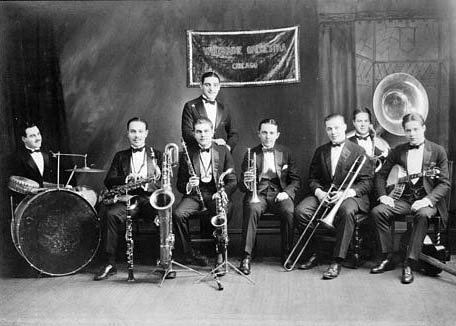 followed
by a two-bar clarinet break and eight bars of the band playing with Bix
dominating over the ensemble. The eight bars played by Bix represent a
variation of what he had played in the six-bar solo. For the next year,
the Melrose stock arrangement of Copenhagen, with variations to fit the
recording band, was recorded frequently. The following are the recordings
of Copenhagen listed in Brian Rust's Jazz Discography for the period
May 1924-August 1925.
followed
by a two-bar clarinet break and eight bars of the band playing with Bix
dominating over the ensemble. The eight bars played by Bix represent a
variation of what he had played in the six-bar solo. For the next year,
the Melrose stock arrangement of Copenhagen, with variations to fit the
recording band, was recorded frequently. The following are the recordings
of Copenhagen listed in Brian Rust's Jazz Discography for the period
May 1924-August 1925.
Wolverine
Orchestra. 5/6/24
Benson
Orchestra of Chicago. 9/8/24.
Sammy
Stewart. 9/24
Al
Turk. 10/24
Oriole
Orchestra. 10/18/24
Varsity
Eight. 10/22/24
New
Orleans Jazz Band. 10/23/24
California
Ramblers. 10/23/24
Fletcher
Henderson. 10/30/24
Arkansas
Travellers. 11/19/24
Savoy
Orpheons. 1/21/25
Alex
Hyde. 6/25
Julian
Fuhs Follies Band. 6/25
The
tune made it across the Atlantic Ocean as witnessed by one recording in
England (Savoy Orpheons) and two recordings in Germany (Alex Hyde and Julian
Fuhs). Most of the above recordings utilize the Melrose stock arrangement
and include clarinetist Jimmy Hartwell’s and saxophonist George Johnson’s
12-bar solos. As far as Bix’s solo is concerned, of the above recordings
that I had access to, those by the Benson Orchestra of Chicago, Al Turk,
the Oriole Orchestra, the Varsity Eight, the California Ramblers and the
Savoy Orpheons include either note for note copies or cornet solos that
follow quite closely Bix’s solo. The recording by Fletcher Henderson includes
a solo by Louis Armstrong completely different from Bix’s. The Arkansas
Travellers’ version follows in general the pattern of the Melrose arrangement,
but all solos are different from those in the Wolverines recording. In
conclusion, the recording ofCopenhagen
by the Wolverines contains the second example of a Bix solo copied -in
this instance- by several cornet/trumpet players.
Tiger
Rag.
Using
Brian Rust’s Jazz Discography as the source, it will be seen that Nick
La Rocca’s composition Tiger Rag was the second most recorded tune
between 1898 and 1942: it was recorded 113 times compared to 135 times
for “St. Louis Blues.” The first recording of Tiger Rag dates from
August 17, 1917 by the Original Dixieland Jazz Band. The ODJB recorded
Tiger
Rag again on March 25, 1918 for Victor (18472). This recording had
a profound effect on 16-year old Bix. Charles “Burnie” Beiderbecke, Bix’s
brother, described Bix’s reaction to Philip Evans. “When Bix heard these
records [“Tiger Rag” and “Skeleton Jangle”] it was his first exposure to
jazz. He loved them and played them constantly, studying each note with
his legs crossed, his head almost in the bell, oblivious to all of us.
It was then he borrowed a beat-up cornet from a neighbor … Bix taught himself
to play the cornet by slowing down “Tiger Rag” playing it note for note
with his ear in the bell.”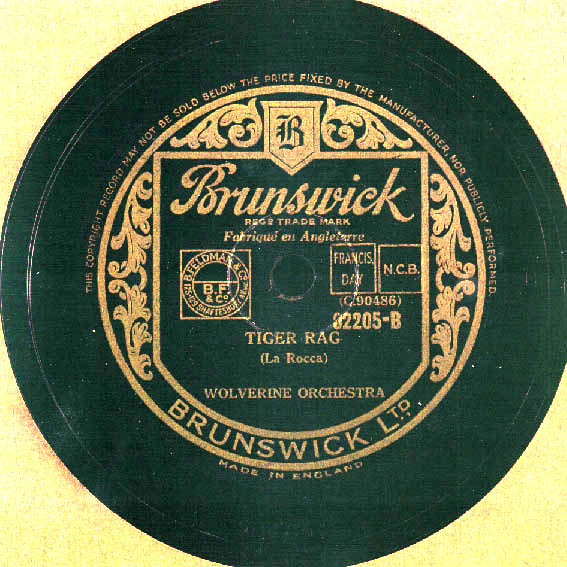
The
Wolverine Orchestra with Bix recorded Tiger Rag on June 20, 1924,
the third recording session of the Wolverines for the Richmond Gennett
studios. On the same day, the Wolverine Orchestra recorded INeed
Some Pettin and Royal Garden Blues. The latter two recordings
were issued in the Gennett 20,000 series (20,062) reserved for “vanity”
or “personal” records. Only test pressings of the third number cut on that
day –Tiger Rag- were made. Members of the orchestra paid for the
test pressings and received copies of them. It must be emphasized at this
point that commercial recordings of Tiger Rag were not released
until 1936.
Within
three years of the Wolverine’s recording of Tiger Rag, the following
four recordings of the song -relevant to the theme of the present article-
were released.
May
4, 1925. California Ramblers (under various pseudonyms depending on the
record label: Five Birmingham Babies, Goldie’s Syncopators, etc.). Red
Nichols and Frank Cush on trumpet.
May
12, 1926. University Six. Chelsea Quealey on trumpet.
May
1926. Purple Pirates Orchestra. Unknown cornetist.
December
1927. Devine’s Wisconsin Roof Orchestra. Dick Happe and Alec Alexander
on trumpet.
What
is remarkable about the above four recordings issued in the time period
1925-1927, long before the first commercial release of the Wolverines'
Tiger
Rag in 1936, is that they all feature a trumpet solo that is nearly
a note for note copy of Bix’s cornet solo in the Wolverine’s recording
of “Tiger Rag” Brad Kay had noted in 1999 the close similarity between
Bix’s solo and the solo in the Purple Pirates Orchestra recording. In an
Internet forum (www.network54.com) Brad Kay wrote, “Bix's solo on this
delayed release of “Tiger Rag” was copied almost note-for-note by the cornetist
on a 1926 record of “Tiger Rag” by the Williams College (Massachusetts)
“Purple Pirates” jazz band. This was a one-off issue for sale at the college.
The mystery is: How did the cornet player get to know this solo? Was someone
at Williams hip enough to have one of those precious Wolverines Gennett
tests? Or was the solo transcribed from the test to a stock arrangement
used by this band and others? Or what?!?” In his LP notes to the 1979 Sunbeam
MFC-21, producer Alan Roberts also mentions the similarity of the Purple
Pirates cornet solo to the Bix solo. In the same Internet forum, Frank
van Nus noted recently that Red Nichols’ and Chelsea Quealey’s solos are
very similar to each other and to Bix’s solo. He writes, “Like Quealey's
solo, the Nichols solo is identical to the Bix solo in the first 12 bars.
Where Bix seems to shy just before the break, Nichols finishes the little
riff Bix started (as does Quealey), and then produces a whole-tone break
identical to the Quealey one. After the break, he follows the general direction
of the Quealey solo. All in all, there are more similarities between Quealey
and Nichols than between either of them and Bix. From this I conclude that
Nichols and Quealey were reading from the same source - either hand-written
or printed.” Malcolm Walton in the same Internet forum and Richard Sudhalterin
Lost
Chords also noted the similarity between Quealey’s and Bix’s solos.
Sudhalter writes, “How, then, had Quealey, in New York, heard this performance?
It is conceivable that Beiderbecke or another of the Wolverines had a copy
and played it for him - but Quealey's performance here betokens careful
listening and imitation.” The 1927 recording by Devine's Wisconsin Roof
Orchestra presents additional features of interest. Tracks 14 and 15 of
the Jazz Oracle Bill Carlsen 1926-1928 CD (# BDW 8014) are takes
1 and 2, respectively, of Tiger Rag, recorded in December 1927 by
Devine's Wisconsin Roof Orchestra. (18]. There is a trumpet solo in takes
1 and 2. The two solos are different from each other, although the construction
and lengths are the same. The solo in take 1 could be described as a variation
on Bix's solo in the Wolverines' version of “Tiger Rag.” On the other hand,
the solo in take 2 is clearly a copy of Bix's solo, not quite note for
note, but extremely close. We have what I view as a remarkable event. A
trumpeter emulates [not the style, but the improvisation] Bix, not only
by copying one of his solos, but also by providing an alternate take with
a variation on Bix's solo! Just like we are told repeatedly that Bix did
not replicate his solos in different takes, the trumpeter in Devine’s Wisconsin
Roof Orchestra comes up with two
different
solos in the two takes of Tiger Rag.
The
similarity of the cornet solos in recordings of Tiger Rag issued
shortly after that of the Wolverines -in view of the fact that the Wolverines
recording was not issued commercially until 1936- presents indeed a mystery.
It is possible, as Sudhalter suggests that one of the trumpet players had
a copy of a test pressing of the Wolverines Tiger Rag. But it is unlikely
that the four trumpeters had copies of test pressings at their disposal.
I would like to offer the following hypothesis to explain this rather unusual
puzzle.
As
I indicated during the discussion of Jazz Me Blues, Bix and Red
Nichols met early in July 1924, about two weeks after the Wolverines had
recorded Tiger Rag. I suggest that, at that time, Bix gave Red a
copy of the test pressing of the recently recorded Wolverines' Tiger
Rag. This proposal is quite reasonable. Bix had a number of test pressings
and he was willing to share one of them with a kindred soul. Fast forward
to May 1925, Red is recording Tiger Rag with the California Ramblers.
He remembers the test pressing of the Wolverines recording and listens
to it. Red likes what he hears and copies Bix's solo. Now the solo, as
part of the arrangement for Tiger Rag, is in the California Ramblers
book. Comes May 1926, the University Six (a small contingent of California
Ramblers musicians) record Tiger Rag and Chelsea Quealey uses again
Bix's solo. Thus, we have a credible explanation for Red and Chelsea Quealey
playing solos in their versions of “Tiger Rag” identical to each other
and very similar to the one created by Bix in 1924. The Purple Pirates
Orchestra could not have copied their solo from the University Six recording:
the two recordings were made at about the same time. It is likely that
the cornetistcopied the solo from
the California Ramblers recording. As far as Devine’s Wisconsin Roof Orchestra,
the trumpeter could have copied either the California Ramblers or the University
Six recording, but ultimately, the original model was Bix’s solo.
The
count of copies of Bix's solo in Tiger Rag is now up to four: California
Ramblers, University Six, Purple Pirates, and Devine's Wisconsin Roof Orchestra.
Not bad for a record that was not released commercially and for which only
test pressings were available in the 1920s!
In
conclusion, I find it remarkable that Bix’s solos from tunes in his first
three recording sessions –JazzMe
Blues, Copenhagen, and Tiger Rag- were copied almost
note for note by other trumpeters shortly after Bix’s original recordings.
I believe such copies represent a testimony to Bix’s genius for composition
and improvisation and to the admiration that fellow musicians held for
Bix.
Acknowledgments.
I am grateful to all the contributors to the Bixography Forum http://www.network54.com/Hide/Forum/27140
who added useful comments to the discussion of the issues covered in the
present article, Bill Dean-Myatt, Rick Kennedy, Norman Field, Malcolm Walton,
and the late Frank Powers. Correspondence with Bill Haesler is gratefully
acknowledged. Michael Kieffer kindly sent me a copy of the Purple Pirates
Orchestra version of Tiger Rag. I am grateful to Jean-Pierre Lion
for a copy of the Storyville article. I am particularly indebted to Brad
Kay and Frank van Nus: without their critical, insightful contributions,
the present article could not have been written. Brad and Frank read an
earlier draft of the article. They made several important suggestions that
were incorporated in the final version of the manuscript.
Recommended Reading
(2)
Richard M. Sudhalter, Lost Chords, White Musicians and Their Contributions
to
Jazz, 1915-1945,
Oxford University Press, New York, 1999,p.
451.
(3)
Randy Sandke, Bix Beiderbecke From a Musician's Perspective in
Annual
Review of Jazz Studies, 9, 1997-98, edited by Edward Berger, David
Cayer,
Henry Martin, Dan Morgenstern, Institute of Jazz Studies, Rutgers-
The
State University of New Jersey and The Scarecrow Press, Inc., Lanham,
Maryland
and London, 2000, pages 165-260.
(4)
Philip R. and Linda K. Evans, Bix: The Bix Beiderbecke Story, PrelikePress,
Bakersfield,
California, 1998.
(5)
Charlie Davis, That Band From Indiana, Mathom Publishing Company,
Oswego,
NY, 1982.
(6)
Brian Rust, Jazz Records 1897-1942, 4th edition, Arlington
House, New
Rochelle,
New York, 1978.
[7]
Bruce Allen Hardy, Charlie Davis, Copenhagen and the Musical Culture
of
the
’20s,
Storyville,